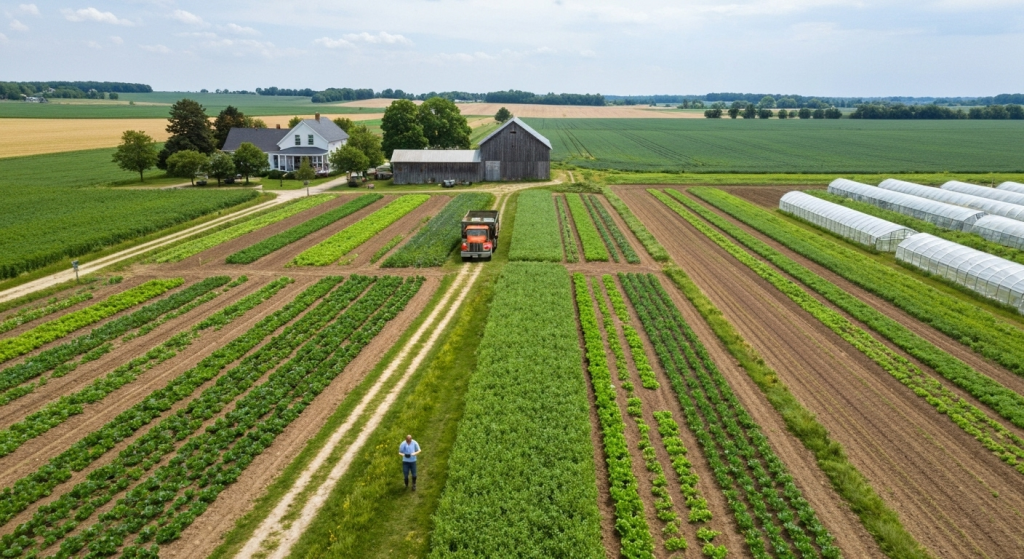The global supply chain disruptions of recent years taught us one crucial lesson: flexibility beats size every time. While massive corporations struggled with rigid systems, small artisan food businesses showed remarkable resilience. Their secret wasn’t advanced technology or deep pockets—it was agility.
As someone who has spent the last five years working directly with food businesses across different scales, I’ve witnessed this transformation firsthand. My name is Richard Boren, and I’ve helped dozens of artisan producers navigate supply chain challenges while consulting for larger food manufacturers. The contrast in their approaches reveals powerful lessons about modern supply chain management.
What Makes Artisan Food Businesses Different

Small artisan food producers operate in a completely different world than large manufacturers. They work with limited resources, shorter production runs, and closer relationships with both suppliers and customers. These constraints, which might seem like disadvantages, actually create unique strengths.
The typical artisan bakery sources flour from three local mills, maintains relationships with farmers within 50 miles, and adjusts recipes based on seasonal availability. This approach requires constant adaptation but creates multiple pathways for sourcing ingredients.
Large food manufacturers traditionally focus on efficiency through standardization. They lock in contracts with single suppliers, optimize for volume discounts, and design processes around consistent inputs. This model works well in stable conditions but becomes a liability during disruptions.
Key Characteristics of Artisan Supply Chains
Artisan food businesses share several common traits that enhance their flexibility:
Local Sourcing Networks: Most artisan producers maintain relationships with multiple local suppliers. A craft brewery might source hops from five different farms instead of one large distributor. This redundancy costs more per unit but provides security.
Seasonal Menu Adaptation: Unlike chain restaurants with fixed menus, artisan establishments regularly adjust offerings based on ingredient availability. A farm-to-table restaurant changes its menu monthly, working around what local farms can provide.
Direct Supplier Relationships: Artisan producers often know their suppliers personally. They visit farms, understand growing conditions, and maintain communication throughout the season. These relationships enable quick problem-solving when issues arise.
Smaller Inventory Commitments: Limited storage space forces artisan businesses to order frequently in smaller quantities. This seemingly inefficient approach actually reduces risk during volatile periods.
Core Flexibility Strategies That Work

Through my consulting work, I’ve identified five key strategies that artisan food businesses use to maintain supply chain flexibility. These approaches can be scaled and adapted for larger operations.
Strategy 1: Multiple Supplier Relationships
The most successful artisan producers never rely on single sources for critical ingredients. They cultivate relationships with multiple suppliers, even if it means paying slightly higher prices or managing more complexity.
A small-batch hot sauce maker I worked with sources peppers from four different farms. When disease wiped out crops at two farms in 2023, production continued without interruption. The additional supplier relationships cost about 8% more in normal times but prevented a complete production shutdown.
Implementation for Larger Companies: Big manufacturers can apply this principle by developing secondary and tertiary supplier relationships. Instead of 100% single-sourcing, consider 70-20-10 splits across multiple suppliers for critical materials.
Strategy 2: Recipe and Product Flexibility
Artisan businesses excel at adapting their products when specific ingredients become unavailable. They view recipes as guidelines rather than rigid formulas, making substitutions that maintain quality while working around shortages.
During the 2022 sunflower oil shortage, a local bakery I advised switched to olive oil for certain products and coconut oil for others. Customers barely noticed the difference, and some products actually improved. The bakery turned a supply crisis into a product innovation opportunity.
Scaling This Approach: Larger companies can build flexibility into their product development process by creating approved substitution lists for non-critical ingredients and training production teams to implement changes quickly.
Strategy 3: Inventory Optimization Over Volume Discounts
While large companies chase volume discounts through big orders, artisan businesses optimize for freshness and flexibility. They order smaller quantities more frequently, reducing waste and maintaining cash flow.
A cheese maker I consulted with orders milk every three days instead of weekly. This approach costs 12% more in delivery fees but ensures fresher product and reduces spoilage by 30%. The net result is better margins and happier customers.
ApproachOrder FrequencyInventory CostSpoilage RiskFlexibility ScoreTraditional (Large Orders)Weekly/MonthlyLowHigh2/10Artisan (Frequent Small Orders)Daily/Every 3 DaysMediumLow8/10Hybrid Model2-3 Times WeeklyMediumMedium6/10
Strategy 4: Local and Regional Focus
Artisan producers build supply chains within smaller geographic areas. This approach reduces transportation complexity, supports local economies, and creates more resilient networks.
The craft distillery I helped optimize sources all grains within 200 miles of their facility. When national grain prices spiked in 2023, local prices remained stable due to lower transportation costs and regional market dynamics.
Benefits of Regional Sourcing:
- Reduced transportation costs and risks
- Better supplier relationships through proximity
- Faster response times during disruptions
- Support for local economic networks
- Lower environmental impact
Strategy 5: Technology for Transparency
Modern artisan businesses use simple technology tools to maintain visibility across their supply networks. They track supplier performance, monitor inventory levels, and communicate changes quickly.
A specialty coffee roaster implemented a basic tracking system that monitors green bean inventory, supplier delivery schedules, and quality scores. This visibility allows them to spot potential issues weeks before they impact production.
Real-World Applications and Results
The flexibility strategies used by artisan businesses deliver measurable results. Companies that implement these approaches see improvements in resilience, customer satisfaction, and often profitability.
Case Study: Artisan Cheese Producer
One cheese maker I worked with faced a crisis when their primary milk supplier experienced contamination issues. Because they maintained relationships with three local dairy farms, they redirected their entire supply within 48 hours. Production continued without interruption.
The recovery process involved:
- Immediate communication with backup suppliers
- Quality testing of alternative milk sources
- Minor recipe adjustments to accommodate slight variations
- Customer communication about temporary packaging changes
Total downtime: Zero days. Compare this to a major dairy company that faced a similar issue and required three weeks to qualify new suppliers through their procurement process.
Scaling Success: Mid-Size Food Company Transformation
A regional food manufacturer with $50 million in annual revenue adopted artisan-inspired flexibility principles. They replaced single-source contracts with multiple supplier relationships and invested in supplier development programs.
Results after 18 months:
- Supply disruption incidents decreased by 60%
- Average recovery time dropped from 12 days to 3 days
- Supplier relationship scores improved by 40%
- Overall supply chain costs increased by 4% but product availability improved by 25%
Challenges and Limitations
Implementing artisan-style flexibility isn’t without challenges, especially for larger organizations. Understanding these limitations helps companies develop realistic implementation strategies.
Higher Administrative Costs
Managing multiple suppliers requires more paperwork, relationship management, and coordination. A single procurement manager might handle relationships with five suppliers instead of one. This increases costs but also distributes risk.
Quality Consistency Concerns
Working with multiple suppliers can introduce variability in raw materials. Artisan businesses address this through detailed specifications, regular quality testing, and process adjustments. Larger companies need robust quality management systems to handle this complexity.
Regulatory Compliance Complexity
Food safety regulations require extensive documentation and traceability. Multiple suppliers multiply these requirements. Companies need systems that can track ingredients through complex supply networks while maintaining compliance.
Scale Economics Trade-offs
Smaller, more frequent orders typically cost more per unit than large bulk purchases. Companies must balance these higher costs against the value of improved flexibility and reduced risk.
Implementation Roadmap for Different Business Sizes
The path to supply chain flexibility looks different depending on company size and current systems. Here’s how businesses can start implementing these strategies.
Small Businesses (Under $5M Revenue)
Small businesses can implement artisan strategies immediately since they often already operate with shorter planning cycles and closer supplier relationships.
Month 1-2: Map current supplier relationships and identify critical single-source ingredients. Begin developing relationships with backup suppliers for the most critical items.
Month 3-4: Implement simple tracking systems to monitor supplier performance and inventory levels. Spreadsheets work fine at this stage.
Month 5-6: Test recipe flexibility by experimenting with ingredient substitutions during normal operations, before crises force changes.
Medium Businesses ($5M-$100M Revenue)
Medium-sized companies need more structured approaches but can still move quickly compared to large corporations.
Quarter 1: Conduct comprehensive supply chain risk assessment. Identify vulnerabilities and single points of failure in current supplier networks.
Quarter 2: Develop supplier diversification strategy. Begin qualifying secondary suppliers for critical materials. Negotiate flexible contract terms that allow for volume adjustments.
Quarter 3: Implement enhanced inventory management systems that provide real-time visibility into stock levels and supplier performance.
Quarter 4: Train production teams on flexibility protocols. Create decision trees for ingredient substitutions and supplier switches.
Large Enterprises ($100M+ Revenue)
Large companies face the biggest challenges in implementing flexibility due to established systems and corporate inertia. However, they also have resources to create sophisticated solutions.
Year 1: Pilot programs in specific product lines or geographic regions. Test flexibility strategies on smaller scale before company-wide implementation.
Year 2: Technology infrastructure development. Implement advanced supply chain visibility systems that can handle multiple supplier relationships and complex decision-making.
Year 3: Cultural transformation and training. Shift procurement mindset from cost optimization to risk management and flexibility.
Measuring Flexibility Success
Successful supply chain flexibility requires measurement systems that go beyond traditional cost metrics. Companies need to track resilience, adaptation speed, and relationship quality.
Key Performance Indicators
Supply Chain Resilience Score: Measures ability to maintain operations during disruptions. Track percentage of production maintained during supplier interruptions.
Supplier Relationship Quality: Regular surveys and performance assessments of supplier partnerships. Strong relationships predict better crisis response.
Adaptation Speed: Time required to implement workarounds or switch suppliers when problems arise. Best-in-class artisan businesses achieve switches within 24-48 hours.
Cost of Flexibility: Track the premium paid for maintaining multiple supplier relationships against the value of avoided disruptions.
Benchmarking Against Industry Standards
Artisan food businesses typically maintain 3-5 supplier relationships for critical ingredients compared to 1-2 for traditional manufacturers. They also carry 2-3 weeks of inventory versus 4-6 weeks for larger companies.
These differences reflect fundamentally different approaches to risk management. Artisan businesses accept higher day-to-day costs in exchange for dramatically reduced disruption risk.
Technology Tools for Enhanced Flexibility
Modern technology enables artisan-style flexibility at larger scales. The right tools can help companies maintain multiple supplier relationships while controlling complexity and costs.
Supply Chain Visibility Platforms
Cloud-based platforms provide real-time visibility into supplier performance, inventory levels, and potential disruptions. These systems alert managers to problems before they impact production.
Supplier Relationship Management Tools
Specialized software helps companies maintain detailed profiles of multiple suppliers, track performance metrics, and manage communication. These tools make it practical to work with dozens of suppliers instead of just a few.
Inventory Optimization Software
Advanced algorithms help companies balance the costs of carrying inventory against the risks of stockouts. These tools support more frequent, smaller orders while maintaining service levels.
Communication and Collaboration Platforms
Digital tools enable closer collaboration with suppliers, similar to the personal relationships that artisan businesses maintain naturally. Video calls, shared dashboards, and instant messaging create stronger partnerships.
Future Trends and Opportunities

The lessons learned from artisan food businesses point toward broader trends in supply chain management. Companies that adopt these principles early will have competitive advantages as markets become more volatile.
Increased Local Sourcing
Environmental concerns and transportation costs are driving more companies toward regional sourcing strategies. This trend aligns perfectly with artisan flexibility principles.
Circular Economy Integration
Artisan businesses naturally minimize waste through close supplier relationships and flexible processes. This approach becomes more valuable as sustainability regulations increase.
Consumer Transparency Demands
Customers increasingly want to know where their food comes from. The close supplier relationships that enable flexibility also support transparency requirements.
Climate Change Adaptation
Weather volatility requires more flexible sourcing strategies. Companies with diverse supplier networks and adaptation capabilities will handle climate impacts better.
Frequently Asked Questions
Q: How much does implementing supply chain flexibility typically cost? A: Initial costs range from 3-8% of current supply chain spending, but most companies see net savings within 12-18 months through reduced disruption costs and improved efficiency.
Q: Can large companies really achieve the same flexibility as small artisan businesses? A: Not exactly the same level, but they can achieve significant improvements. Large companies won’t match artisan speed but can reduce their vulnerability by 50-70% through strategic flexibility investments.
Q: What’s the biggest barrier to implementing these strategies? A: Corporate culture and procurement policies designed around cost minimization rather than risk management. Changing these systems requires leadership commitment and patience.
Q: How do you maintain quality consistency with multiple suppliers? A: Detailed specifications, regular testing, and strong supplier development programs. The key is investing in supplier relationships and quality systems rather than relying on single-source control.
Moving Forward with Supply Chain Flexibility
The artisan food business model offers a blueprint for building more resilient supply chains. Their success comes from embracing relationships over systems, flexibility over efficiency, and adaptation over optimization.
Companies ready to implement these strategies should start small, measure results carefully, and build organizational support for change. The businesses that master supply chain flexibility will thrive in an increasingly uncertain world.
The path forward requires balancing the artisan approach with the scale requirements of larger operations. This means selective implementation, thoughtful technology adoption, and cultural change that values resilience alongside efficiency.
Smart companies are already making this transition. They’re building supplier networks that can bend without breaking, creating products that adapt to available ingredients, and developing teams that thrive on change rather than fear it.
The question isn’t whether supply chains will face more disruptions in the future—they will. The question is whether your organization will be ready to adapt, or whether it will break under pressure like so many rigid systems before it.



